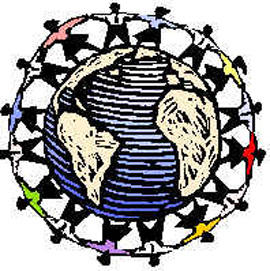
UCSB Hist 2c: World
History, 1700-pres.
The "Global Village"
Handout for Discussion Section, Week 1(Hist 2c Course homepage, Prof's homepage)
created February 13, 2007, updated 3/31/08
 |
The "Global Village" Handout for Discussion Section, Week 1(Hist 2c Course homepage, Prof's homepage) created February 13, 2007, updated 3/31/08 |
The Global Village
[note 3/31/08: I am preparing a 2008 version that will supercede this one.
See the background history by by Carolyn Jones at odtmaps.com.]
If we could shrink the earth's population to a village of precisely 100 people, with all the existing human ratios remaining the same, it would look something like this [compare to the demographics of the 2006 2c course]: |
[1] Source: UN Department of Economic and Social Affairs, Population Division, "World Population Prospects: The 2000 Revision." [2] Source: U.S. Bureau of the Census International Data Base, Table 094: Midyear Population by Age and Sex 2001. [3] Source: U.S. Bureau of the Census International Data Base, Table 001: Total Midyear Population 2001, assuming the populations of South America, Asia, and Africa are "non-white" and those of North America, Europe, and Oceania are "white." Source: Britannica Book of the Year 1999, "Religious Population of the World, 1998," reprinted at infoplease.com, using numbers from the "Christians" heading only for the Christian percentage. [5] Source: The International Herald Tribune, February 5, 1999, cited in the World Income Inequality table. [6] Source: Habitat for Humanity International, "Why Habitat is Needed." [7] Source: UNICEF, "The State of the World's Children 1999." [8] Source: UN Food and Agriculture Organization report, cited at OBGYN.net. [9] Source: U.S. Census Bureau, World Vital Events Per Time Unit 2001. [10] Source: UNESCO Institute for Statistics, World Education Indicators, Gross Enrollment Ratio by Sex. [11] Source: UN Human Development Indicators, "Access to Information and Communications 1995." |